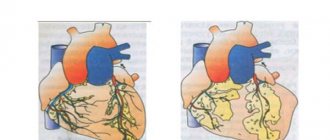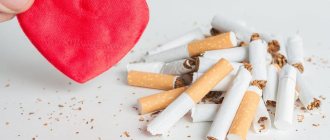Everyone knows that smoking is one of the bad habits of our time. But, unfortunately, not everyone thinks about the effect of nicotine on blood vessels and the heart. And although we all know about the harmful effects on the lungs, it is the blood vessels and heart that suffer first. If humanity gave up cigarettes, how many human lives could be saved. However, people have smoked and will continue to smoke, and their health suffers. Smoking has a particularly negative impact on the blood vessels of the brain and legs.
What's in a cigarette?
The tobacco business is constantly evolving and today the production of cigarettes is significantly different from the banal stamping of cigarettes from tobacco and tissue paper. To the detriment of consumer health, a wide range of chemically hazardous substances are used in tobacco products today. Among the 4 thousand (approximately) items, tar, nicotine, hydrocyanic acid, carbon monoxide, and nitric oxide deserve special attention.
Resins are oily compounds that have a dark brown color and a sticky texture. Due to the fact that they are not water-soluble, the resins settle on the surfaces of blood vessels in a dense film, having a poisonous and irritating effect on the organs. At the same time, the amount of oxygen entering the blood decreases, and the efficiency of blood circulation decreases.
Nicotine belongs to a number of alkaloids that have a psychotropic effect on humans. It is a metabolic product of plants of the nightshade family. Nicotine derivatives are used to make insecticides. A particularly dangerous free form of nicotine destroys the cellular structure of tissues, but is quickly eliminated. At the same time, the person experiences an urgent need for a new dose.
Hydrocyanic acid affects the central nervous system, irritating chemoreceptors. Acute oxygen starvation occurs in the tissues. Other gases also do not have a beneficial effect.
The chemical composition of smoke from hookah smoking, e-cigarette smoking and similar cigarette “substitutes” is similar, and it also causes damage to the cardiovascular system.
How does a bad habit affect the state of the body?
In the process of smoking, a person, without noticing it, is faced with a huge number of effects of tobacco on blood vessels:
- when smoking, the blood thickens and there is a serious risk of blood clots forming in the vessels;
- with increased cholesterol during smoking, plaques form on the walls of blood vessels, which can completely block the lumen and lead to ischemic stroke;
- In people who smoke, blood vessels become sluggish, lose elasticity, and their lumens become smaller. It is extremely difficult to clean a vessel completely;
- Heavy smokers often experience cerebral hemorrhage.
It is important to know: smoking reduces memory, kills brain cells, and a person begins to degrade. This is explained by the fact that when you puff, the amount of oxygen entering the body decreases.
Brain cells begin to die, blood circulation is impaired
This is explained by the fact that when you puff, the amount of oxygen entering the body decreases. Brain cells begin to die and blood circulation is disrupted.
Does nicotine constrict or dilate blood vessels?
It is believed that nicotine constricts blood vessels. Is it so? During smoking, nicotine is involved in all chemical and nervous reactions of the body.
After inhaling, nicotine is oxidized in the body, and part of the nicotine constituents - metabolites - are released during urination.
However, carbon dioxide manages to have a negative effect on the cardiovascular system and narrows the lumen of blood vessels. The narrowing of blood vessels has an extremely negative effect on human health. The brain, legs and heart suffer.
How does smoking affect the blood vessels of the heart?
People who smoke often become hypertensive – their blood pressure constantly fluctuates. Doctors make a diagnosis of nicotine hypertension. If your blood pressure is high, your heart needs more strength to pump blood. But this is impossible with constant poisoning of the body with nicotine doses.
In addition, in people who smoke, the walls of blood vessels are affected by atherosclerosis, and this is the cause of the development of blood clots. Doctors come to the same conclusion that myocardial infarction is often caused by an addiction. Nicotine is also the culprit of angina and ischemia.
This whole set of undesirable pathologies occurs due to the fact that carbon monoxide provokes spasms of the blood vessels of the heart, and this affects the thickening and coagulability of the blood.
How does smoking affect the blood vessels of the brain?
Smoking affects the brain even more negatively than other organs. After carbon monoxide enters the human body, cholesterol plaques are deposited on the blood vessels of the brain.
I recently read an article that talks about the natural cream “Bee Spas Kashtan” for treating varicose veins and cleaning blood vessels from blood clots. With this cream you can cure VARICOSIS FOREVER, eliminate pain, improve blood circulation, increase the tone of veins, quickly restore the walls of blood vessels, clean and restore varicose veins at home.
I’m not used to trusting any information, but I decided to check and ordered one package. I noticed changes within a week: the pain went away, my legs stopped “humming” and swelling, and after 2 weeks the venous lumps began to decrease. Try it too, and if anyone is interested, below is the link to the article.
If you don’t immediately quit a bad habit, there is a high probability that painful symptoms will lead to a stroke. If a person feels that headaches, dizziness, attacks of nausea and weakness, or numbness of body parts are becoming frequent, he should immediately consult a doctor. If one stroke is experienced and no conclusions are drawn, a second stroke ends in death.
How does smoking affect the blood vessels in the legs?
The blood vessels in the legs suffer from smoking, and this has long been no secret. After nicotine enters the body, the arteries suffer and the blood supply to the vessels deteriorates. The first symptoms of a serious pathology of the legs are pain in them and limping.
The most common leg diseases are endarteritis and atherosclerosis. In atherosclerosis, blood vessels become clogged with plaque.
If no treatment occurs, the plaques thicken and the leg tissue suffers. Sadly, both diseases lead to gangrene. Smoking can also lead to the formation of blood clots, and a disease such as thrombophlebitis.
For the treatment of VARICOSE and cleaning blood vessels from THROMBUS, Elena Malysheva recommends a new method based on the Cream of Varicose Veins. It contains 8 useful medicinal plants that are extremely effective in the treatment of VARICOSE. Only natural ingredients are used, no chemicals or hormones!
How does nicotine affect blood vessels?
The body perceives the effect of nicotine on the cardiovascular system as a serious danger. Due to the contact reaction of nicotine with transmembrane receptors and depolarization of cells, leading to a sharp release of adrenaline into the blood, rapid breathing appears and the heart rate increases.
On average, the heart of a smoker makes 20,000 more beats in 24 hours than the heart of a healthy person. Blood pressure increases, capillaries and blood vessels contract sharply, and wear and tear on the circulatory system continues for about an hour after smoking.
What happens to blood vessels during smoke breaks - do they expand or contract?
Nicotine entering the body causes vasospasm:
- in the first minutes after smoking a cigarette, the blood vessels dilate , but this does not last long;
- within 10-15 minutes they narrow , which leads to an increase in heart rate and a jump in pressure upward; the condition returns to normal after 30 minutes.
On average, each smoker smokes about a pack of cigarettes per day (20 pieces), therefore, 6-7 hours a day the blood vessels are in spasm due to the effects of nicotine on them.
Spasm is the main cause of circulatory problems in the organs and tissues of a smoker. Poor circulation leads to insufficient oxygen supply to organs and tissues, aging processes and various dangerous diseases develop .
Visually evaluate how the bad habit affects the blood vessels - photos of the blood vessels of a smoker and the blood vessels of a non-smoker.
Effect of cigarette smoke
Substances contained in cigarette smoke spread through the bloodstream in 7 seconds (faster in adolescents), affecting the entire body.
Carbon monoxide molecules (carbon monoxide) displace oxygen in the blood, causing acute oxygen starvation of tissues. In this case, cell death occurs throughout the body.
Oily resin compounds envelop platelets and adhere to the walls of blood vessels. The resulting blood clots in arterial vessels can lead to myocardial infarction, thromboembolism, and stroke. All these diseases have no characteristic symptoms and develop rapidly.
Smoke poses a great danger to the brain; dysfunction can make a smoker disabled.
The harmful effects of nicotine
Let's see what happens to the vessels at the moment when the smoking process takes place.
Imagine a working water pump powered by a motor. It pumps water and transports it from one point to another. During normal operation, its walls contract and are reflected externally by pulsating dynamic movements. The same thing happens with arteries during their normal functioning: they perform the function of transporting blood from one organ to another, saturating them with oxygen and beneficial nutrients. At the moment when a person takes a puff, part of the nicotine formed in the process of pyrolysis (burned under the influence of high temperature smoke) enters the lungs, and a moment later, by seeping through the alveoli into the blood, it is located in the vessels of the brain.
What happens? The vessels spasm, and the spasms themselves provoke their narrowing and expansion. Pull after pull, the contraction of blood vessels is carried out more and more intensely. Constantly narrowing arteries impede the movement of blood flow, oxygen starvation occurs. At some point, the smoker feels slight euphoria, relaxation, and a slightly noticeable stupor. Meanwhile, the water moving through the previously mentioned water pump undergoes obstacles on its way, the load on the motor doubles, it begins to work more actively and uses reserve power. The heart has no reserve. Its increased work and the stress placed on it are accompanied by a rapid heartbeat, increased blood pressure and high-frequency pulsation. This is how hypertension develops.
Effect on the blood vessels of the heart
Smoking causes a chronic lack of oxygen, which causes serious problems in the functioning of the heart. Vascular spasms and clogging with cholesterol accumulations over a long time cause harm to the heart without obvious signs.
Heaviness in the chest and pain radiating to the left arm are rarely associated with a pre-infarction condition. The risk of developing dangerous heart diseases increases when smoking.
With so-called passive smoking, the processes in the body are similar. A smoker harms not only himself, but also those around him.
How to avoid consequences
In addition to the above pathologies, the influence of nicotine can lead to cancer, loss of vision, deterioration of the skin and other ailments. It doesn’t matter how long you smoke: a month, a year or 10 years. It's never too late to quit a bad habit. As mentioned above, after a person quits smoking, the body is completely restored after some time. To avoid consequences, follow these recommendations:
- Quit smoking cigarettes completely and irrevocably. To quit a bad habit, first of all, a person must want it himself.
- Eat right. Make sure your daily diet is rich in vitamins and microelements. Avoid fatty, smoked and spicy foods. Give preference to dietary meat, fresh fruits and vegetables.
- To quickly cleanse your body of accumulated waste and toxins during smoking, try to drink as much water as possible. The best option is 2 liters per day.
- To restore your body faster, take complex vitamins. They saturate the body with useful microelements that the smoker’s body lacks.
- If there are no contraindications, play sports, spend more time in the fresh air and go for walks.
Once you quit this bad habit, you will soon notice many positive changes:
- The color and condition of the skin improves. The face becomes more ruddy, acquires a pleasant pink tint, the skin becomes more elastic and toned.
- The discomfort experienced by smokers disappears. These include headaches and fatigue in the morning, rapid fatigue, decreased performance, shortness of breath and increased heart rate.
- Nasal congestion, which accompanies smokers throughout life, disappears.
- The sense of smell is normalized. Smells and tastes become brighter and richer.
- Appetite and the functioning of the gastrointestinal tract are normalized.
- Metabolism accelerates.
- The feeling of constant lack of sleep disappears.
- The final benefit is that it improves your mood, as it is so nice to know that you are no longer dependent on a pack of cigarettes. Plus, deciding to quit smoking will save you money and time.
Constriction of blood vessels when smoking leads to various disruptions in the functioning of the body. To avoid all negative consequences, give up your bad habit as soon as possible.
Almost every second person has a nicotine addiction. When inhaling cigarette smoke, a large number of toxins and poisons enter the individual’s body, which causes the blood vessels to narrow. Smoking with VSD has life-threatening consequences. A cigarette relieves pain, but instead takes away several days of life.
Nicotine, smoking and brain vessels
Between periods of exposure to tobacco smoke on blood vessels, the body strives to normalize its own processes. Therefore, the state of the vessels is constantly changing, some of them become sclerotic, some areas maintain tone for a long time or, conversely, expand and lose elasticity, collaterals appear - new areas of the vascular system. Thus, the blood pressure in the vessels of smokers is distributed unevenly during blood flow.
Such changes in the blood supply system to the brain lead to constant hypoxia, disturbances in psycho-emotional balance, serious interruptions in mental activity, and metabolic processes in the body.
The indirect effects of nicotine on blood vessels also deserve attention:
- Nicotine inhibits the secretion of prostacyclin. This hormone stimulates the receptors of smooth muscle cells of arterial vessels, relieving vascular tone, thereby lowering blood pressure. Lack of prostacyclin leads to chronic dysfunction of the vasculature.
- Contact reactions of nicotine with tissues destroy their structure at the cellular level. Damaged cells are unresponsive to the body's needs, and the production of useful elements occurs in incomplete quantities. Calcium deficiency, for example, leads to problems in muscle function.
- Often, a smoker has to choose between full treatment of diseases and smoking, since the effect of nicotine on the liver reduces the protective functions of the body as a whole, and makes any therapy ineffective, and untreated diseases become chronic.
Brain circulation
The effect of nicotine on the blood vessels of the brain is characterized by extremely dangerous effects. An increase in blood density and constriction of blood vessels provokes insufficient tissue nutrition. At the same time, there is a possibility of blockage of the lumen with a plaque. Failure of cerebral circulation ultimately manifests itself:
- dyscirculatory encephalopathy;
- dementia;
- stroke.
The initial stage of cerebral vascular pathology will manifest itself:
- frequent headaches and dizziness;
- ringing in the ears;
- decreased vision (due to narrowing of blood vessels in the eyes);
- memory impairment;
- general weakness;
- decreased performance.
The main risk group consists of people whose blood vessels are damaged to a significant extent. These are usually older men with high blood pressure and cholesterol.
Cholesterol plaques are deposited in the cerebral arteries. The result is blockage of the arteries. With a small diameter of the lumen of the vascular bed, a person suffers from constant migraines, and there is a deterioration in the qualitative characteristics of thinking processes: memory, concentration, reaction speed. Changes in mental state occur: depression, irritability, and aggressiveness are typical. Migraines are not relieved by analgesic drugs. One possible complication is cerebral hypoxia. Cells die, mental abilities decrease, and VSD develops.
Nicotine and VSD
Long-term smoking can lead to serious diseases of the nervous system, since dangerous tar compounds and psychotropic substances are constantly entering the body.
A common myth is the analgesic effect of nicotine in vegetative-vascular dystonia. In fact, nicotine affects nerve cells, thereby temporarily reducing the body's susceptibility to the causes of pain. The brain incorrectly analyzes its own state and reacts incorrectly to solving problems.
Cleansing blood vessels after quitting cigarettes
There are no methods or drugs for cleansing after quitting smoking. The body's self-regulation mechanisms will do everything. Yesterday's smoker just has to stay out of the way.
To increase the effectiveness of CVS recovery, you should:
- Stop drinking alcohol and caffeine.
- Take a course of vitamin complexes, taurine - a substance that is used as a food additive and has a positive effect on the cardiovascular system.
- Start physical therapy classes.
- Eliminate fatty and fried foods from your diet.
- Drink more water to detoxify your body.
- Treat chronic diseases.
Compliance with these points will lead to the effective use of self-regulation processes and will have a positive effect on the cardiovascular system and other body systems: nervous, digestive, endocrine.
Consequences of long-term smoking for blood vessels
Depending on the length of smoking, a person acquires various diseases against the background of circulatory disorders:
- hypertension of varying degrees;
- ischemic tissue disease;
- dysfunction of the body's life support systems.
The constant impact of tar compounds on the composition of a smoker’s blood leads to the appearance of the following arterial diseases:
- thromboembolism (sudden blockage of blood vessels with blood clots);
- thrombophlebitis (inflammation of the walls of blood vessels due to blood clots);
- thrombophilia (blood clotting disorders);
- endarteritis (overgrowth of blood vessels with connective tissue);
- vascular atherosclerosis.
Circulation of small blood flow is fraught with changes in color, temperature, and sensitivity of the skin. In combination with liver dysfunction, the skin becomes sallow and patchy, accumulated toxins in the tissues lead to frequent rashes and swelling on the face, back, groin area, and armpits. Frequent headaches, fatigue, sweating and decreased brain function occur due to vascular spasms.
To treat the above diseases, it is necessary to stop using tobacco products and alcohol. The effectiveness of therapy increases significantly.
What systems are affected by the addiction?
The bloodstream reacts to nicotine circulating in the blood. This alkaloid constricts blood vessels, and this effect is realized in two ways - direct and indirect:
- the direct route of action is realized due to the interaction of nicotine with special vascular chemoreceptors, the stimulation of which causes contraction of smooth muscle cells;
- the indirect pathway is realized due to the fact that the alkaloid stimulates the production of adrenaline by the adrenal glands. The latter, in turn, affects the blood vessels, causing them to narrow.
Among other things, it is known that the arteries of smokers are 5 times more likely to be affected by atherosclerosis than the arteries of non-smokers. Atherosclerosis, in turn, is a risk factor for a number of serious cardiovascular diseases, including:
- cardiac ischemia;
- heart attack;
- stroke.
About the harmful effects on the heart
Based on everything that has already been said above, it becomes obvious that smoking significantly increases the likelihood of developing hypertension, as well as atherosclerosis. Thus, the influence of the chain of the following factors has an extremely negative effect on the condition of the heart muscle:
- the blood arteries of the heart are largely exposed to atherosclerosis;
- the development of atherosclerosis in these arteries leads to a significant obstruction of blood flow to the heart muscle;
- arterial hypertension leads to an increase in the load on the myocardium;
- under conditions of inadequate blood flow, as well as increased load, hypoxia develops in the heart muscle tissue.
About the harmful effects on the central nervous system
Nicotine has the ability to stimulate brain activity. It is the effect of a surge of strength, energy, and renewed activity that many smokers refer to, arguing their attachment to the addiction.
Activation of brain activity occurs due to the fact that, under the influence of nicotine, the production of the neurotransmitter dopamine is stimulated, and interneuronal conduction is significantly facilitated. But this effect is short-lived and as soon as the concentration of the alkaloid in the blood decreases, it declines. Afterwards, the reserves of dopamine in the brain cells are depleted, and the person feels a loss of strength, apathy, and perhaps even some lethargy. I want to smoke a cigarette again, a vicious circle occurs.
It is the chronic depletion of dopamine that explains the fact that smokers are 2 times more likely to suffer from depression than non-smokers.
The brain of smokers is always in a state of hypoxia, as well as dopamine depletion, which makes it especially vulnerable to cerebrovascular diseases.
About the harmful effects on the lower extremities
Due to generalized vascular spasm, as well as the development of atherosclerosis, the arteries of the legs often suffer. Smokers are most likely to develop one of the following diseases:
- obliterating endarteritis;
- obliterating atherosclerosis.
The name of each of these diseases begins with the term “obliterating.” Obliteration is a critical narrowing of the lumen of a vessel, possibly even its complete closure, entailing the development of characteristic clinical symptoms. That is, these are those pathologies in which the lumens of the arteries of the legs narrow significantly, preventing normal blood flow. As a result, the soft tissues of the legs experience hypoxia. First, chronic arterial insufficiency develops, and subsequently the risk of developing gangrene of one or even two limbs increases significantly.
Among patients who are hospitalized in surgical hospitals for gangrene of the leg, 80% are experienced smokers.
Vascular restoration using folk remedies
Traditional medicine recipes to maintain the functioning of the circulatory system:
- Potato peel decoction. Peel washed potatoes (500 g) and pour 1 liter of cold water. Take the cooled decoction 0.5 cups before meals for two weeks. It has a complex effect on the cardiovascular system, has a beneficial effect on the walls of the stomach and can be used in cosmetology.
- Tea with milk. Add a couple of tablespoons of milk to a glass of black tea. It is necessary to brew loose leaf tea, since it is the tea leaves that have a tonic effect on the body. And in combination with milk, tea delicately stimulates blood flow and reduces irritability. Take 3-5 times a day for a week.
- Horseradish, lemon and garlic. Grind the ingredients in equal proportions in a meat grinder and add 1/3 of the volume of the slurry with water. Each ingredient is unique in itself. In this combination, the product clearly stimulates the cleansing of the body, starts the process of cell renewal and strengthens the immune system. Drink 1 tablespoon of the product before each meal for 7 days.
Increasing the total mass of plant foods in the diet will help cleanse the walls of blood vessels and intestines.
If possible, you should avoid stress and overeating. Maintenance exercises in the morning and warm baths stabilize the psycho-emotional background and tone. But all this is only after consultation with a doctor, since you can cure one thing, but ruin your stomach or kidneys.
Restore the functioning of blood vessels and compensate for the damage caused
Smoking consistently kills the body, its effect on the body is so large-scale that it is impossible to make tobacco smoke less harmful: a decrease in the amount of nicotine leads to an increase in other harmful substances.
To begin restoring the blood vessels of the brain, you need to completely abandon the bad habit. Passive smoking has almost the same effect on the body as active smoking.
Now let's look at how to restore blood vessels after quitting smoking. First, consult a neurologist to undergo an examination and determine the condition of the brain vessels. The elasticity of the walls of blood vessels is restored without the use of drugs, which occurs naturally in a short period of time: on average, regeneration takes 3-4 weeks.
The vessels then dilate to normal levels to carry enough blood. The brain begins to receive enough oxygen and restores vital processes. Over time, brain cells regenerate.
Metabolic disorders associated with smoking lead to increased cholesterol levels in the blood and deposition on the walls of blood vessels. After quitting smoking, atherosclerotic lesions cannot disappear, so patients need drug therapy and a therapeutic diet.
Mental collapse
The negative impact of smoking is a decrease in the level of intelligence. Preventing the death of human brain cells is much easier than restoring them. This is an incredibly difficult procedure.
As mentioned above, the blood vessels from cigarettes begin to narrow, oxygen enters in scanty quantities. Nicotine smoke instantly destroys cells. Therefore, smokers are more likely to develop diseases associated with mental activity.
Another important point is the weakening of memory, which ensures vasoconstriction. Blood flow to the tissue decreases, the nervous system gradually gets used to nicotine - addiction is caused. Harmful substances enter the brain and blood vessels 7-8 seconds after taking a puff! It is already clear that the effect of smoking on blood vessels is extremely harmful. Only quitting tobacco smoke can make them expand back.
A limping, slow-thinking person, who is constantly worried about shortness of breath, with blood vessels that narrow - this is the portrait of a modern smoker. To this you can add eternal irritability if you can’t take a drag from a cigarette.
What vascular diseases does it provoke?
Nicotine addiction leads to the development of various diseases, but the leading positions are occupied by pathologies of the heart and blood vessels:
- arterial hypertension;
- thrombosis and thrombophlebitis;
- atherosclerosis;
- myocardial ischemia;
- stroke of the brain and kidneys.
Smoking has a particularly negative effect on the health of the fetus, since nicotine and other components penetrate the placental barrier, having a toxic effect on the developing organs and systems of the fetus.
Smoking provokes the development of diseases of the pulmonary-bronchial system, oncology, and sexual impotence. The pathologies are based on vascular insufficiency of varying degrees of intensity.
What is nicotine addiction?
Nicotine is an alkaloid isolated from the seeds and leaves of Nicotiana tabacum, in other words, tobacco. Due to the nicotine contained in the products of the tobacco industry, addiction to tobacco is formed.
Nicotinism is one of the most common addictions, along with caffeine addiction and alcoholism.
The difference from drug addiction is primarily that the physiological functions of the body, which have been excited or changed under the influence of nicotine, stabilize after stopping smoking and return to the optimal level; the effect is reversible.
Compared to many severe types of addiction, this addiction is easily treatable.
This type of stimulant has gained significant popularity due to its legality and not immediately evident negative consequences. Long-term tobacco consumption causes addiction, which occurs at the psychological and physiological levels.
How much does a person need to smoke before he dies?
How many cigarettes do you need to smoke to die? The content in 1 cigarette depends on the brand. On the side of the cigarette pack there is information about the amount of mg. The indicator can be from 0.3 mg to 1.3 mg of nicotine in 1 cigarette.
On average, 1 cigarette contains 1 mg. Considering a lethal dose of 0.5 - 1.0 mg, let's calculate how much it takes to smoke to die. For a person with a body weight of 70 kg, the minimum of cigarettes is life-threatening - 35, maximum - 70.
A person weighing 55 kg will need from 27 to 55 cigarettes to die, and a person weighing 100 kg will need from 50 to 100, respectively. At the same time, a person must smoke them in a short period of time.
Contrary to all calculations, if a person weighing 70 kg smokes 70 cigarettes, he will not die. This is due to the lower content in tobacco smoke - only 30%.
In this case, an even smaller amount of nicotine will enter the blood, and the person will have time to exhale the rest. Formaldehyde will destroy some of it, and the body of a smoker who receives small doses gets used to it over several years.
When smoking a large number of cigarettes, symptoms of acute poisoning will occur, the person will stop smoking and, as a result, the body will not receive a lethal dose.
Cases of death have been described when smoking just 2-3 cigarettes. Nicotine had a toxic effect on the nerve centers, cardiac and respiratory arrest occurred, which led to death.











